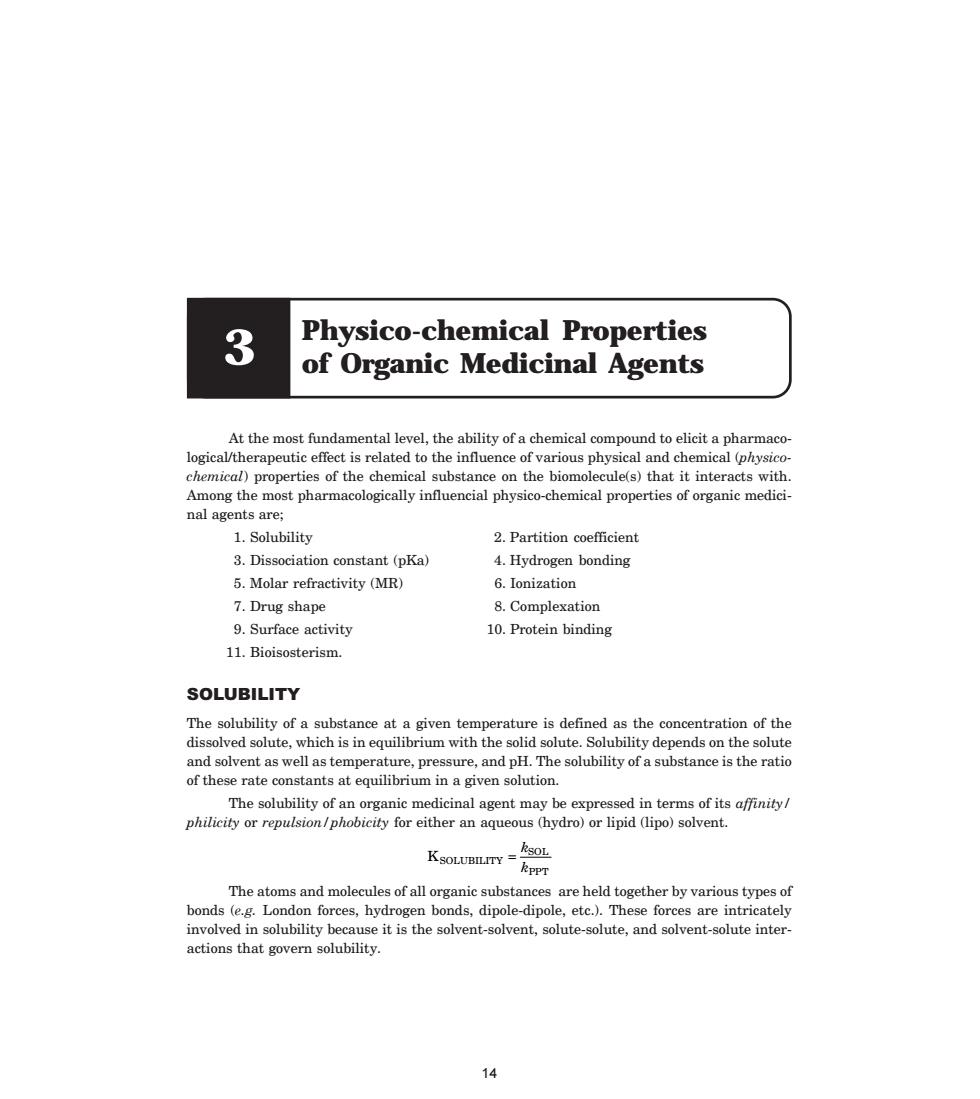正在加载图片...

3 Physico-chemical Properties of Organic Medicinal Agents At the most fundamental level,the ability of a chemical compound to elicit a pharmaco logical/therapeutic effect is related to the influence of various physical and chemical(physic chemical)properties of the chemical substance on the biomolecule(s)that it interacts with Among the most pharmacologically influencial physico-chemical properties of organic medici- nal agents are: 1.Solubility 2.Partition coefficient 3.Dissociation constant(pKa) 4.Hydrogen bonding 5.Molar refractivity (MR) 6.Ionization 7.Drug shape 8.Complexation 9.Surface activity 10.Protein binding 11.Bioisosterism SOLUBILITY The solubility of a substance at a given temperature is defined as the concentration of the dissolved solute,which is in equilibrium with the solid solute.Solubility depends on the solute and solvent as well as temperature,pressure,and pH.The solubility of a substance is the ratio of these rate constants at equilibrium in a given solution. The solubility of an organic medicinal agent may be expressed in terms of its affinity/ philicity or repulsion/phobicity for either an aqueous (hydro)or lipid (lipo)solvent. PPT The atoms and molecules of all organic substances are held together by various types of bonds (e.g.London forces,hydrogen bonds,dipole-dipole,etc.).These forces are intricately involved in solubility because it is the solvent-solvent,solute-solute,and solvent-solute inter- actions that govern solubility 14 3 Physico-chemical Properties of Organic Medicinal Agents At the most fundamental level, the ability of a chemical compound to elicit a pharmacological/therapeutic effect is related to the influence of various physical and chemical (physicochemical) properties of the chemical substance on the biomolecule(s) that it interacts with. Among the most pharmacologically influencial physico-chemical properties of organic medicinal agents are; 1. Solubility 2. Partition coefficient 3. Dissociation constant (pKa) 4. Hydrogen bonding 5. Molar refractivity (MR) 6. Ionization 7. Drug shape 8. Complexation 9. Surface activity 10. Protein binding 11. Bioisosterism.
The solubility of a substance at a given temperature is defined as the concentration of the dissolved solute, which is in equilibrium with the solid solute. Solubility depends on the solute and solvent as well as temperature, pressure, and pH. The solubility of a substance is the ratio of these rate constants at equilibrium in a given solution. The solubility of an organic medicinal agent may be expressed in terms of its affinity/ philicity or repulsion/phobicity for either an aqueous (hydro) or lipid (lipo) solvent. KSOLUBILITY SOL PPT = k k The atoms and molecules of all organic substances are held together by various types of bonds (e.g. London forces, hydrogen bonds, dipole-dipole, etc.). These forces are intricately involved in solubility because it is the solvent-solvent, solute-solute, and solvent-solute interactions that govern solubility. 14